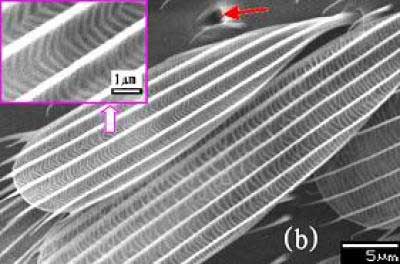| Posted: July 16, 2007 |
Miraculous mosquito legs |
|
(Nanowerk News) Mosquitoes walk on water better than water striders, cling to smooth ceilings and walls as tightly as geckos, and clutch the skin of their victims with annoying tenacity in search of blood. Now a collaboration of physicists from Dalian University in China and Simon Fraser University in Canada are looking beyond the insect's pesky reputation to discover how the tiny creatures manage to be so comfortable on such a diverse range of surfaces.
|
|
Like flies, mosquito feet are equipped with hooked claws for clinging to skin. Like geckos, they have hairy pads on their feet that stick to nearly any smooth surface with a velcro-like grip. But it's their ability to walk on water that really makes mosquitoes stand out in the animal kingdom.
|
 |
A close up of the micronanostructures that help mosquitoes walk on water. (Image: C. W. WU, X. Q. King, and Diane Wu, Physical Review E)
|
|
Both water striders and mosquitoes rely on superhydrophobic (extremely water repelling) legs to allow them to stand on pond surfaces. Water striders' legs do a pretty good job of it, repelling water well enough to support up to 15 times their body weight. Mosquitoes, however, can easily beat that. Experiments now reveal that they repel water so well that each of a mosquito's six legs could support 23 times the insect's weight. The physicists measured the water repellant ability of mosquito legs by attaching an amputated leg to the end of a needle and recording the force as they pushed it down into a container of water.
|
|
The secret to mosquito water walking appears to be feathery scales a few microns across that in turn are covered with nanoscopic ribbing, forming what the physicists have dubbed (in an apparent fit of excessive prefixing) a micronanostructure. So the next time a mosquito lands on your arm, take a moment to ponder its impressive and versatile leg adaptations -- then squish it before it sucks your blood.
|

